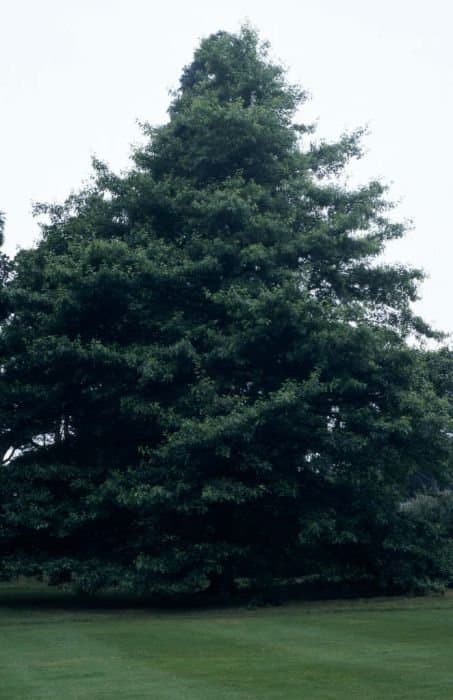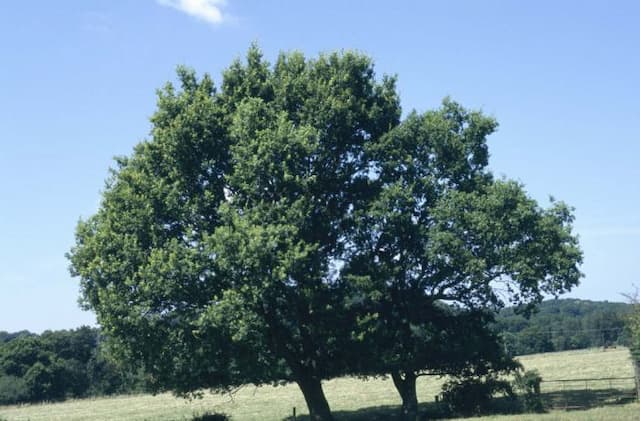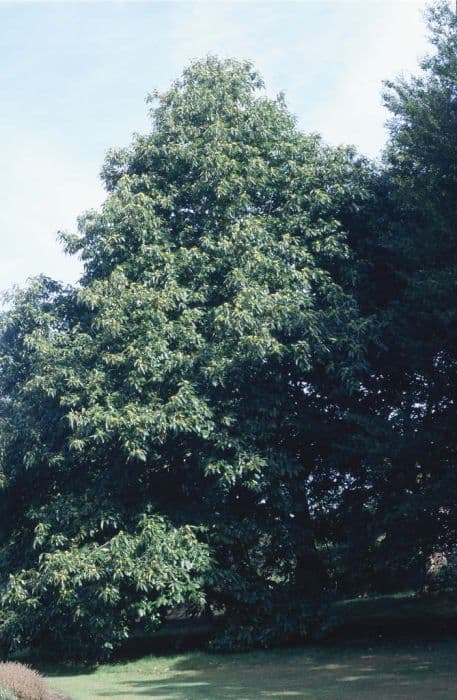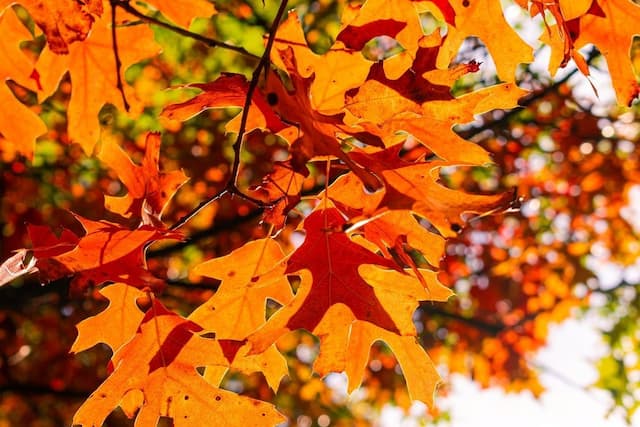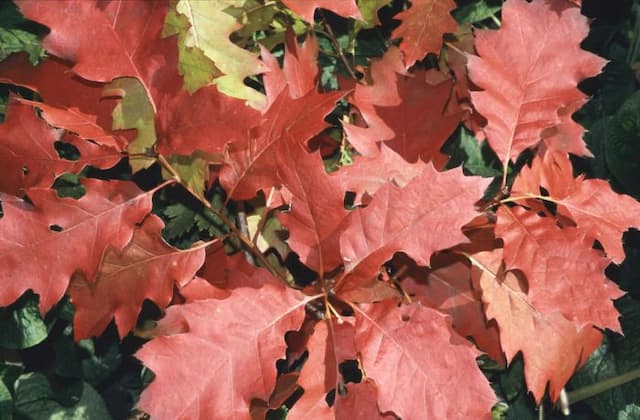Weeping Beech Fagus sylvatica 'Pendula'

ABOUT
The European beech 'Pendula', sometimes known as the Weeping Beech, is a striking deciduous tree recognized for its unique and elegant appearance. This cultivar of the common European beech has a distinctive growth habit, with branches that droop gracefully toward the ground. The leaves of the Weeping Beech are a lush green color in spring and summer, providing a vibrant canopy. Each leaf is oval-shaped with a pointed tip and wavy edges, giving the tree a lush, full appearance. In the fall, the foliage undergoes a transformation, with the green leaves turning to a delightful array of golds, coppers, and bronzes before falling off. This display of autumn color adds visual interest and appeal, making it a favorite for seasonal landscapes. The bark of the Weeping Beech is typically smooth and silvery-gray, providing an attractive contrast to the cascading foliage and making the tree visually appealing even in winter when the leaves have dropped. Overall, the Weeping Beech is celebrated for its dramatic presence and weeping form, creating a focal point in any garden where it becomes a year-round source of beauty. Without going into specifics of size, it's safe to say this selection is considered a specimen tree that may take on a broad spreading form.
About this plant
 Names
NamesFamily
Fagaceae
Synonyms
Weeping Beech, European Weeping Beech, Weeping European Beech, Pendulous Beech
Common names
Fagus sylvatica f. pendula, Fagus sylvatica var. pendula.
 Toxicity
ToxicityTo humans
The Weeping Beech is not commonly known to be toxic to humans. There are no well-documented cases of poisoning or toxic effects from ingesting parts of this tree. However, like many plants, it is not considered edible, and its ingestion is not advised.
To pets
The Weeping Beech is also not toxic to pets. It does not contain any known toxic substances that would cause poisoning in animals such as dogs and cats. Nonetheless, ingestion of non-food items, including parts of this tree, can potentially cause gastrointestinal upset or blockages in pets, and thus, should be avoided.
 Characteristics
CharacteristicsLife cycle
Perennials
Foliage type
Deciduous
Color of leaves
Green
Height
12-24 feet [3.6-7.3 meters]
Spread
15-30 feet [4.5-9.1 meters]
Plant type
Tree
Hardiness zones
4-7
Native area
Europe
Benefits
 General Benefits
General Benefits- Visual Appeal: The Weeping Beech offers a unique and striking appearance due to its pendulous branches and lush foliage.
- Shade Provider: Its dense canopy can create large areas of shade, making it an ideal tree for parks and large gardens.
- Seasonal Interest: The tree exhibits stunning seasonal changes, with leaves turning from green to golden brown in autumn.
- Habitat for Wildlife: Provides food and shelter for various birds, insects, and small mammals.
- Longevity: Known for its long lifespan, the Weeping Beech can be a lasting addition to landscapes.
- Privacy: Due to its dense growth, it can act as a natural privacy screen when planted in rows or groups.
- Soil Enrichment: The falling leaves decompose to enrich the soil with organic matter.
- Erosion Control: Its robust root system can help stabilize the soil and prevent erosion.
- Adaptability: While it prefers well-drained soils, the Weeping Beech can adapt to a variety of soil types and conditions.
 Medical Properties
Medical PropertiesThis plant is not used for medical purposes.
 Air-purifying Qualities
Air-purifying QualitiesThis plant is not specifically known for air purifying qualities.
 Other Uses
Other Uses- Woodworking: The timber of European beech is widely used for furniture making due to its fine grain and good workability.
- Smoking Food: European beech wood chips are commonly used for smoking meats and fish, as it imparts a mild, slightly sweet flavor to the food.
- Musical Instruments: The wood from European beech is sometimes used in the production of musical instruments such as drums, piano actions, and wind instruments for its acoustic properties.
- Turned Objects: Woodturners appreciate European beech for creating wooden bowls, platters, and other turned objects because it has a consistent texture and turns smoothly.
- Flooring: European beech is often used in parquet and other hardwood flooring applications for its hardness and attractive grain.
- Veneer Production: The uniform and attractive grain of European beech makes it suitable for veneer production in cabinetry and paneling.
- Millwork: Often used in architectural millwork, European beech can be found in trims, moldings, and staircase components within buildings.
- Art Sculpture: Carvers and sculptors may choose European beech for its fine grain and ease of carving when creating art pieces.
- Craft Wood: European beech is a popular choice for crafting wood toys, puzzles, and intricate models because it can be finely sanded and holds detail well.
- Joinery: Due to its strong, short grain, European beech is frequently utilized for joinery, particularly in the creation of frames, chairs, and tables.
Interesting Facts
 Feng Shui
Feng ShuiThe Weeping Beech is not used in Feng Shui practice.
 Zodiac Sign Compitability
Zodiac Sign CompitabilityThe Weeping Beech is not used in astrology practice.
 Plant Symbolism
Plant Symbolism- Stability and Strength: The European beech, Fagus sylvatica 'Pendula', often symbolizes stability and strength due to its solid trunk and long lifespan, representing enduring power and resilience.
- Wisdom and Knowledge: In mythology and folklore, beech trees are frequently associated with wisdom and knowledge, as their expansive canopies and presence in ancient woodlands evoke a sense of enduring intellect and understanding.
- Patience and Perseverance: The slow growth rate of the beech tree stands for patience and perseverance, teaching the value of slow, steady development and the rewards of long-term thinking.
- Nourishment and Sustenance: The beechnuts produced by Fagus sylvatica have been used as a source of food for wildlife and humans, symbolizing nourishment, provision, and the nurturing aspect of nature.
- Peace and Serenity: With its smooth, gray bark and graceful weeping branches, the Weeping Beech (Fagus sylvatica 'Pendula') can evoke a feeling of calm and tranquility, making it a symbol of peace and serenity.
 Water
WaterThe Weeping Beech requires watering when the top couple of inches of soil are dry, typically once or twice a week, depending on weather conditions. During the growing season in spring and summer, provide about 2 gallons of water per session to keep the soil consistently moist but not waterlogged. During the dormant season in fall and winter, reduce watering to when the soil is dry to a depth of 4 inches, using 1-2 gallons. Ensure that the water is distributed evenly around the base of the tree and that the soil has good drainage to prevent root rot.
 Light
LightThe Weeping Beech thrives in full sun to partial shade, so the ideal spot would be an area where it can receive at least four to six hours of direct sunlight daily. Too little light can lead to sparse foliage, while too much intense afternoon sun in hot climates may stress the tree, so a balance is essential.
 Temperature
TemperatureThe ideal temperature range for the Weeping Beech is between 60°F and 75°F. It can withstand a minimum temperature of approximately -20°F and a maximum of around 85°F, but extreme temperatures can cause stress. The tree prefers cooler temperatures and may not thrive in regions with very hot summers.
 Pruning
PruningPrune the Weeping Beech to maintain its shape, remove dead or diseased branches, and improve air circulation. The best time to prune is in late winter or early spring before new growth starts. Pruning can be done annually but may not be necessary every year if the desired shape is maintained.
 Cleaning
CleaningAs needed
 Soil
SoilThe Weeping Beech requires well-draining soil with a slightly acidic to neutral pH of about 5.5 to 7.0. A mix containing loam, sand, and organic compost would suit this tree well, providing good drainage and sufficient nutrients.
 Repotting
RepottingWeeping Beech trees planted in containers may need repotting every few years; however, given their size and growth habit, they are not commonly kept in pots long-term.
 Humidity & Misting
Humidity & MistingWeeping Beech trees are adaptable in terms of humidity and do not require specific humidity conditions, thriving in the ambient humidity of their outdoor environment.
 Suitable locations
Suitable locationsIndoor
Weeping Beech is not suitable for indoor growth due to its size.
Outdoor
Plant in well-draining soil, full sun to partial shade, and give ample space to grow.
Hardiness zone
4-7 USDA
 Life cycle
Life cycleFagus sylvatica 'Pendula', commonly known as Weeping Beech, begins its life cycle with seed germination, which occurs in spring following stratification, a period of cold to break dormancy. The seedling stage follows germination, characterized by initial root development and the emergence of the first leaves, requiring adequate moisture and light. As the seedling matures into a sapling, more complex root systems and a stronger stem develop, establishing a more robust structure. The sapling then enters a prolonged period of vegetative growth, eventually maturing into an adult tree capable of reproduction; this stage is marked by the development of a weeping canopy and the annual production of flowers and nuts. The tree reaches sexual maturity after several years, with flowers typically appearing in spring followed by the production of triangular beechnuts that are disseminated by wind and animals, facilitating the spread of progeny. Finally, in its mature phase, the Weeping Beech continues to reproduce annually, can live for several centuries, and undergoes natural senescence before eventually dying.
 Propogation
PropogationPropogation time
Late Winter to Early Spring
The most popular method of propagation for Fagus sylvatica 'Pendula', commonly known as the Weeping Beech, is by grafting. Grafting is typically performed in late winter or early spring before the buds break. In this process, a stem with leaf buds is inserted into the stock of a tree. The cambium layers (growing layers) of both the scion, which is the part of the tree that is being grafted, and the rootstock must be placed in contact with one another. This method allows for the distinctive weeping form of the 'Pendula' variety to be reliably reproduced on rootstocks that confer certain advantages, such as increased hardiness or disease resistance. After the scion and rootstock are joined, they are held together with grafting tape or a similar material to keep the joint secure until the graft has taken, which generally takes a few weeks.
